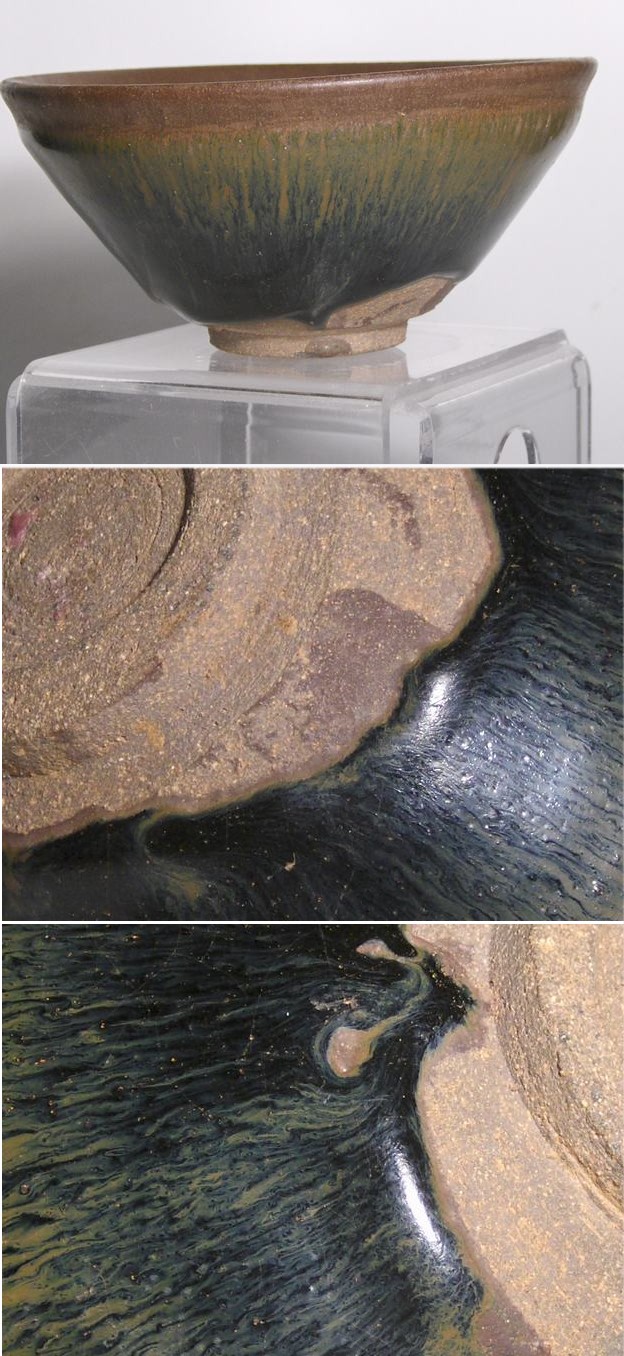
Temmoku bowl. Song Jian ware hare's fure.
Image courtesy Michael Kwan Coll. 2009
Temmoku (天目, also spelled "temmuko", "temoku" and "tenmoku") is a type of glaze that originates in imitating Chinese Jian ware (建盏) of the southern Song dynasty (1127–1279).
The Chinese name Jian yao is because this ware was made at the Jian kilns in the province of Fujian. The Jian ware was first made during the Song Dynasty (960-1279) and is normally only referring to tea bowls.
The Temmoku (Jian Yao) glaze is usually blue-black streaked or mottled with a lustrous brown. Sometimes the brown is the base color and the mottling and streaks are in black. A famous variety; a streaked "Hares fur" with a shinning black glaze showing fine radial rust-colored streaks that resemble the fur of a hare or the markings of a partridge. The characteristic Jian yao tea bowl is conical in shape and has a coarse reddish-black stoneware body.
Although during the Tang dynasty Celadon-glazed bowls had been the most admired for tea drinking, the even greater enthusiasm for tea during the Song dynasty saw a number of changes. Tea parties became the vogue and tea contests were often held at one of the many tea houses. Connoisseurs prided themselves on their ability to prepare tea, and contests were devised for the preparation of so-called whipped tea, which was whisked to produce a white froth on the top. Since the winner was the person whose froth lasted the longest, having a bowl whose color showed the froth to advantage was soon regarded as desirable. Black tea bowls became fashionable and were made at a number of kilns in north and south China, including the Jian kilns of Fujian.
In his Cha lu (Record of Tea) Cai Xiang noted that: "The froth of the tea is seen most clearly in a tea bowl with black glaze. The tea bowls made at Jian'an have purplish black glaze with hare's fur pattern. The body is slightly thicker and so retains the heat well. It is excellent."
Tea drinking was also popular at court and the Northern Song Emperor Huizong (r. AD 1101-1125) was a great devotee of tea drinking and wrote a twelve-chapter dissertation Da Guan cha lun (Discussion of Tea in the Daguan period). He, too, admired Jian hare's fur tea bowls and stated: "The black hued tea bowls are to be preferred. Those with the distinctive hare's fur glaze are the best."
The name Temmoku is actually the Japanese pronunciation of the Chinese mountain Tianmu Shan where an important Buddhist monastery was located. In general this name is often used for a much wider group of black and russet brown bowls than the actual 'Jian ware'.
According to tradition, Japanese Buddhist monks who brought these bowls together with the custom of drinking tea back to Japan visited this temple. The use for the tea was as a mean to stay awake during meditating and nightly religious ceremonies.
Jian ware hare's fur bowls were greatly admired within China and also in other Asian countries, most notably Japan. A few of these old original monk tea bowls of this type have been preserved in Japan, where they have been handed down from generation to generation and are individually named and kept as national treasures.
The name Temmoku has been used indiscriminately to include all black and brown glazed tea bowls from this period. Nowadays efforts are made more precisely to identify the kiln or area in which Song and Yuan tea bowls were made.
Still being an appreciated example of Song ceramics many collectors have turned away from these Song Jian black glaze bowls after repeated disappointments, the fakes are just too convincing. On hand inspection is necessary for a valid opinion. What to look for beside the obvious signs of shape and size are the following characteristics, which might reveal a fake but not guarantee a genuine, are:
1) Sound when tapped- If high pitch, its a fake. Fakes might have a dull thump sound too but a high ring is a sign of a fake.
2) Any glaze age crackles visually and under 10x plus loupe- If none, most likely a fake.
3) Any 'gold' sparkling dust under 10x plus loupe- If yes, its likely real.
4) Any repairs at mouth rim- If yes, its a good sign. Fakes might be repaired too but almost all genuine ones are kiln wasters dug up from the kiln area during the 20th century.
5) Is the base/foot ring soft or sharp when you twist it gently in your palm- If it has any age to it, the foot rim should be worn smooth. Any new pieces straight from the kiln are likely to be sharp. So, while a smooth base is no guarantee for age, a sharp base is a bad sign.
Finally the thick glaze joining the body clay near the base often appears as if they are still shrinking.
A